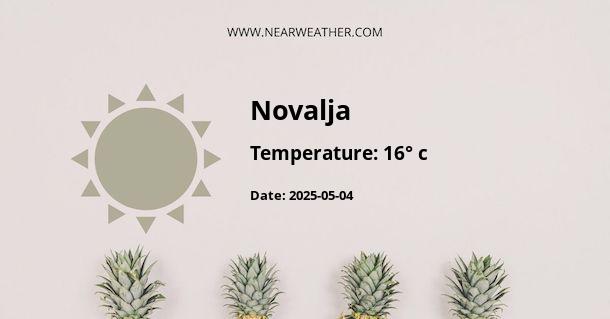Climate and Weather Overview of Novalja, Croatia
Novalja is a picturesque coastal town situated on the island of Pag in the Adriatic Sea, which is part of Croatia, a country with a typically Mediterranean climate known for its clear waters and beautiful beaches. As a tourist destination, Novalja is particularly renowned for its vibrant nightlife and the famous Zrće Beach, which attracts visitors from around the globe. Understanding the climate and weather patterns year-round can greatly enhance the experience for travelers and locals alike, providing insight into the best times to visit and what to expect in terms of temperature, precipitation, and sea conditions.
Geographical Influence on Novalja's Climate
"Novalja's unique location at the northern part of the island of Pag exposes it to various climatic influences, including the moderating effects of the Adriatic Sea and the occasional harsh winds from the Velebit mountain range."
Seasonal Weather Patterns
Spring
- March to May: The spring season witnesses a gradual rise in temperatures, with average daily highs ranging from 12°C (54°F) in March to 21°C (70°F) by May. It marks the end of the cold winter season, with rain becoming less frequent, allowing for the lush greenery to thrive in the island's Mediterranean landscape.
Summer
- June to August: Summer is the peak tourist season in Novalja, characterized by hot, dry weather. Average high temperatures hover around 28°C (82°F), occasionally reaching into the low 30s (86+°F). The Adriatic Sea reaches welcoming temperatures, ideal for swimming and water sports. Rainfall is minimal, making it the perfect time for outdoor activities and beach life.
Autumn
- September to November: Autumn sees a gradual decrease in temperatures and an increase in precipitation. The sea remains warm enough for swimming in early autumn, with temperatures ranging from 20°C (68°F) in September to 14°C (57°F) by November. Autumn is marked by the advent of the Maestral wind, which can bring cooler air and sometimes higher waves.
Winter
- December to February: Winter in Novalja is mild compared to continental Europe, with average highs of around 9°C (48°F) and lows around 3°C (37°F). This season has the highest amount of rainfall, although snow is extremely rare due to the maritime influence. Winter also experiences the Bora wind, a cold, northeasterly wind which can affect temperatures and sea conditions.
Monthly Temperature and Precipitation Overview
| Month | Average High (°C) | Average Low (°C) | Precipitation (mm) |
|---|---|---|---|
| January | 9 | 4 | 75 |
| February | 10 | 4 | 65 |
| March | 12 | 6 | 65 |
| April | 16 | 9 | 65 |
| May | 21 | 13 | 55 |
| June | 25 | 17 | 45 |
| July | 28 | 20 | 35 |
| August | 28 | 20 | 45 |
| September | 24 | 17 | 85 |
| October | 19 | 13 | 85 |
| November | 14 | 9 | 120 |
| December | 11 | 5 | 120 |
Wind and Sea Current Patterns
The island of Pag and consequently, Novalja, are subject to several local winds which have significant influence on the local weather and sea conditions. The most notable are the Bora, a cold and dry northeasterly wind, and the Jugo or Scirocco, a moist southeasterly wind which often brings rain. The summer Maestral wind is a welcome cooling breeze on hot summer days. Understanding these wind patterns is not only crucial for the comfort of visitors but also for those engaging in nautical activities.
Climate Adaptations and Local Culture
Residents and local businesses in Novalja are well-adapted to the regional climate. The architecture incorporates features designed to handle the heat of the summer and the sometimes strong winds. Local cuisine also reflects the seasonal availability of ingredients, with a focus on fresh seafood in the summer and heartier dishes in the cooler months. Festivals and events are timed to take advantage of the pleasant weather, particularly those occurring in the summer season.
Expert Opinions and Future Projections
According to climate experts, the Mediterranean region, including coastal Croatia, may experience shifts in weather patterns due to global climate change. This could lead to more extreme weather events, variations in annual precipitation levels, and rising average temperatures. While these changes pose challenges, it's imperative for tourist destinations like Novalja to adapt and prepare for future weather-related impacts.
Tourist Recommendations Based on Climate
For tourists looking to enjoy the bustling nightlife and ideal beach conditions, the recommended visit time is during the peak summer months of June through August. However, those interested in a quieter vacation with mild weather might prefer late spring (May) or early autumn (September to mid-October). Visitors looking to experience local culture, gastronomy, and perhaps a more authentic experience should consider visiting outside the peak tourist season when the town returns to its routine and traditional lifestyle.
Final Considerations for Visitors
When planning a trip to Novalja, Croatia, visitors should be mindful of the potential impact of the local weather and climate on their travel plans and activities. By understanding the seasonal patterns and utilizing detailed monthly weather data, tourists can optimize their vacation experience to enjoy all that Novalja has to offer, in sync with nature's rhythm. Preparedness for the occasional strong wind and understanding sea conditions can ensure not only a more enjoyable stay in Novalja but also a safer one.
A - Novalja's Latitude is 44.557781 & Longitude is 14.886670.
A - Weather in Novalja is 11° today.
A - Climate Conditions in Novalja shows broken clouds today.
A - Humidity in Novalja is 50% today.
A - Wind speed in Novalja is 22.75 km/h, flowing at 159° wind direction. today.
